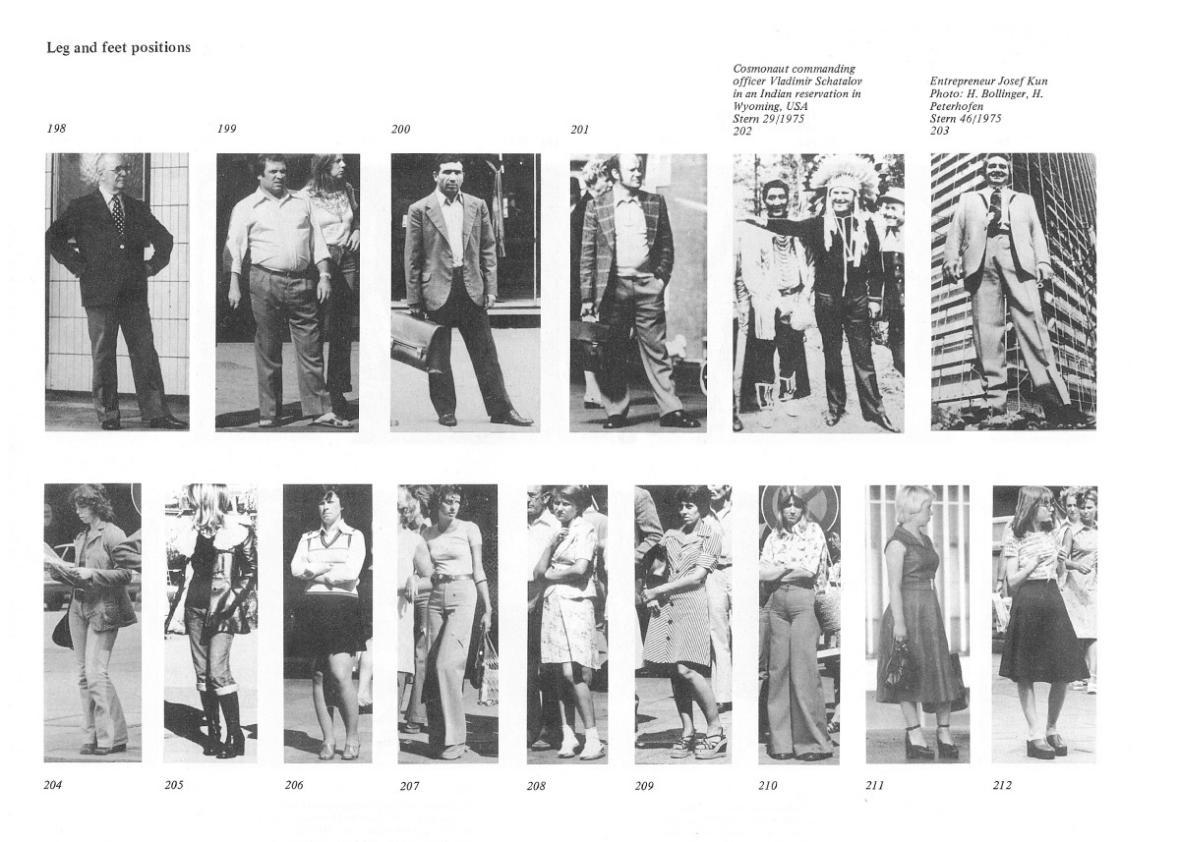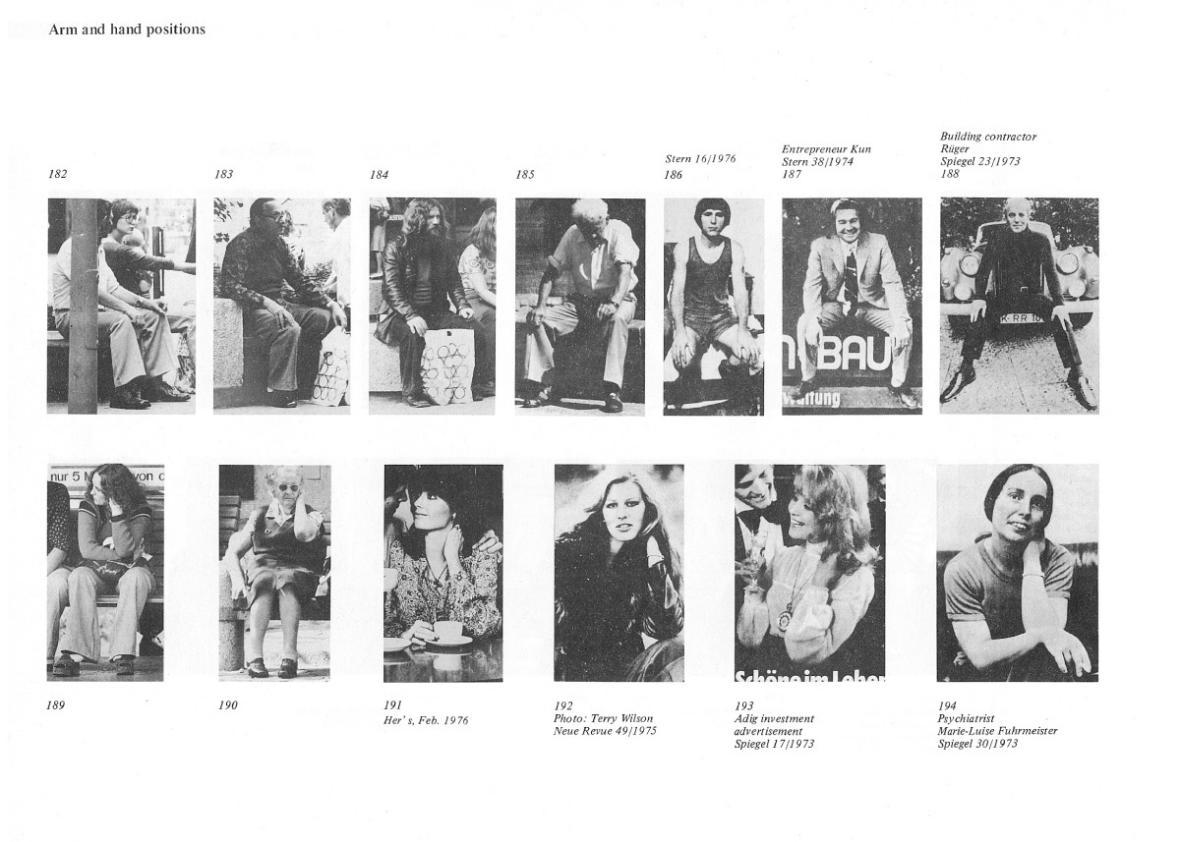Though the term manspreading is a recent addition to the personal-is-political feminist lexicon, the posture itself has a history that spans centuries and continents. Compare Michelangelo’s David, extending his marble leg in nude confidence, to the Venus de Milo, coyly angling her knee toward her other leg. In ancient Greece and Renaissance Italy alike, the bodies of men have expanded to fill available space, and women have folded themselves inward.
Insofar as there is a scholarship of manspreading, German photographer Marianne Wex is a seminal thought-leader. Her 1979 book Let’s Take Back Our Space: Female and Male Body Language as a Result of Patriarchal Structures is one of the most extensive pieces of visual research into men taking up way too much space ever published. Translated into English in 1984, the photobook, brought to Slate’s attention by Tristan Bridges at Sociological Images, contains around 5,000 photographs of men and women in a wide range of postures and settings. Many images are candids, taken by Wex in and around Hamburg. Other photos, of models and celebrities, are taken from advertisements and German magazines.
Wex groups photos of people in similar positions—sitting, crossing their legs, standing with weight on one leg, lying down with bent legs, putting their hands behind their heads—page by page, with men on the top and women on the bottom. It’s no scientific study, but it’s a fascinating compendium of body language that illuminates, for the less dedicated observer of humanity, how people perform gender by placing their body parts in specific geometric combinations.
Researchers have claimed that men manspread while sitting because their knees act like a cat’s whiskers, testing for and claiming space that their extra-wide shoulders need. I rebutted this spurious justification a year ago, and continue to believe that most excuses for manspreading are totally bogus. Men are uncomfortable when they’re forced to point their knees forward? Cool, women are uncomfortable when they have to contort themselves into tiny spaces to avoid touching a man’s knee. Men need more room because their testicles get smushed? Show me the man with testicles that take up an extra half-seat on the subway, and I’ll show you a man with an urgent health problem.
Manspreading apologists should be forced to study Let’s Take Back Our Space, which makes a convincing visual argument for manspreading as socially replicated performance rather than physiological necessity. The biggest piece of supporting evidence the book reveals to that end is that wide-spread knees are just the tip of the sprawling male iceberg. There’s the David–Venus de Milo discrepancy: When people stand favoring one foot, men often put their other leg straight out, while women fold their free leg in line with the other. And there’s been very little discussion of arm placement during manspreading: Men often spread their elbows or place their hands on their knees, arms straight. Wex depicts similarly seated women with their arms folded, one hand in their hair or on their face, elbows tucked neatly toward their belly buttons.
Women also take particular care to take up less space when they’re around men, Wex theorizes, noting that women are more likely to stand with their feet pointed outward if they’re in single-gender groups. The total effect of paging through this painstaking catalogue of observations may be complete paralysis in the public sphere—once you see it in Wex’s book, you’ll see it everywhere, and may find yourself stifling the urge to berate yourself or others for complying with patriarchal norms of body language every time someone crosses her legs. For some reason, there is a slideshow of the entire book available on YouTube if you’d like to burden your daily movements with gendered elbow and knee paranoia.

Let’s Take Back Our Space

Let’s Take Back Our Space
Let’s Take Back Our Space also contains a section inspecting Greek, Roman, and Egyptian statues for signs of manspreading in ancient civilizations. (The Statue of Liberty, too, is examined for her “weighted/unweighted leg posture,” though her robes conceal much of the evidence.) There are few hard conclusions to be drawn from her limited, heavily curated sample, but it’s funny to imagine a pharaoh spreading his legs on the subway while Aphrodite neatly crosses her ankles. The only thing worse than a man with outstretched knees is a man with outstreched knees set, for eternity, in stone.
